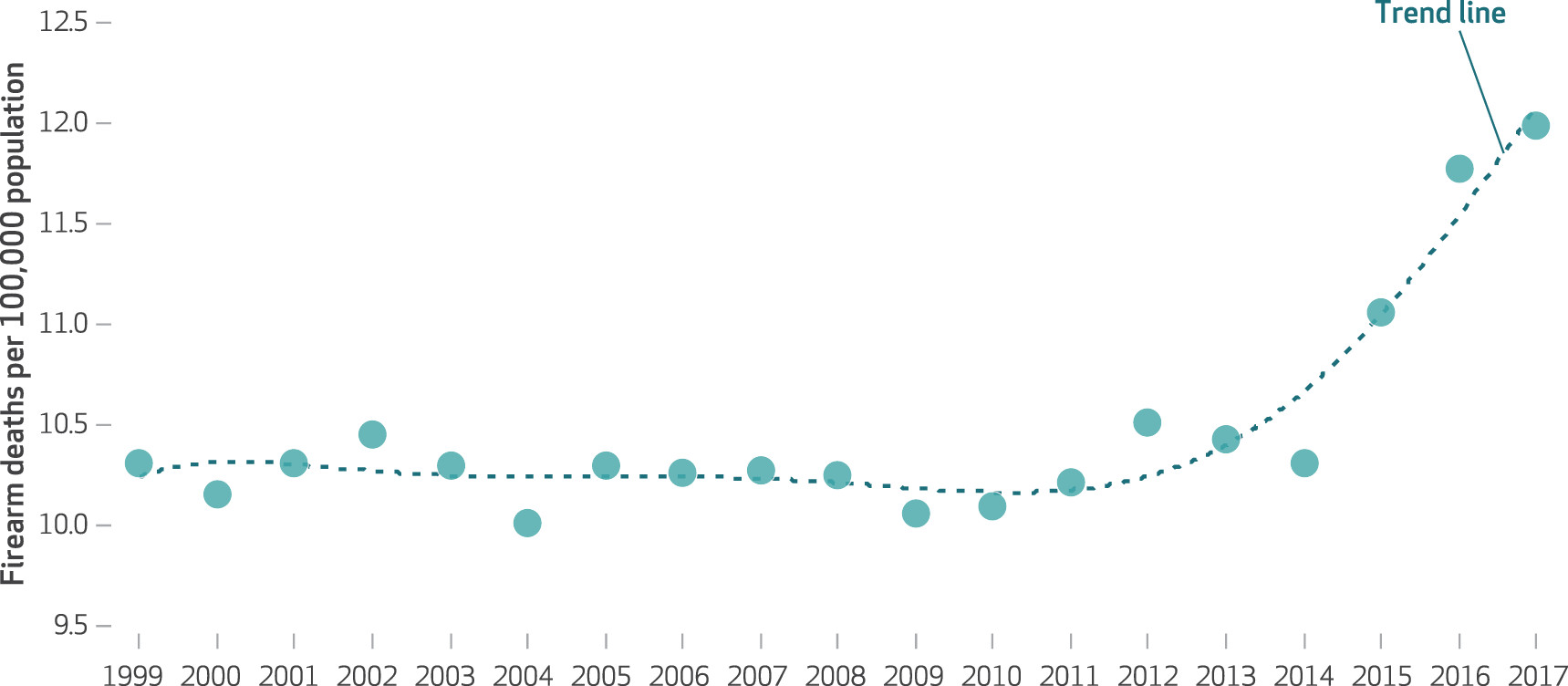Health and Healthcare
US Gun Deaths Are a 'Worsening Epidemic' and in These 4 States by Over 50%

Published:
Last Updated:

Between 1999 and 2014, U.S. firearms deaths totaled 487,627. From 2014 through 2017, firearms were the means in another 114,683 deaths. The death rate from firearms rose from 10.5 per 100,000 person-years during the initial period to 11.8 per 100,000 person-years in the three-year period through 2017. That represents a 13.8% increase in firearms-related deaths.
Of the nearly half-million deaths in the first 15-year period, 58.6% were suicides, and 38.5% were homicides. In the period between 2014 and 2017, 60.0% of firearm deaths were suicides, and 37.9% were homicides.
The data was reported on Monday in a study published at the Health Affairs website that was conducted by researchers from the University of Michigan Medical School, Michigan State University School of Criminal Justice, and the University of Pittsburgh Graduate School of Public Health. The researchers combed through state-level data maintained by the U.S. Centers for Disease Control and Prevention (CDC). They extracted available data for firearm-specific deaths and mortality rates by subpopulations based on sex, race/ethnicity, and age.
The CDC suppresses data when counts are less than 10, so the results are affected by the missing data. The study also does not consider nonfatal firearm injuries, and the researchers had to interpolate some data. The primary focus of the research was the sharp increase in firearm deaths in the three-year period compared to the previous 15-year span. The authors note: “Theoretically, this increase could have arisen from random variation. However, the consistency we found across states and subpopulations makes that possibility less likely.”
The following chart from the study illustrates the sharp increase in firearm deaths of the period from 1999 to 2017.
The next chart illustrates firearm mortality by sex, race/ethnicity and mechanism of death.
Only nine states and the District of Columbia (D.C.) had lower firearm mortality rates in 2017 than in 1999. D.C. had the largest decline, down 43.7%, followed by New York (27.7%), Rhode Island (14.8%) and California (14.4%). The other six states with lower mortality rates in 2017 were Arizona, Connecticut, Hawaii, Maryland, Nebraska, and Nevada.
More than half the states had increases of more than 20% in firearm deaths between 1999 and 2017. The four states with the largest increases during the period were North Dakota (79.9%), Missouri (64.1%), Ohio (62.5%), and New Hampshire (58.2%). The following map from the study shows the percentage changes, by state, from 1999 to 2017.
The researchers noted one common feature among 21 states. All showed marked increases in mortality between the two periods, and the increase “was reflected to varying degrees across demographics and mechanisms of death. This suggests a worsening epidemic of firearm mortality that is geographically and demographically broad.”
They also note that “suicide remains the most common mechanism of firearm mortality in most states, and the availability of a firearm dramatically increases the lethality of a suicide attempt.” In areas with higher rates of mental health problems that may lead to suicide (substance abuse, for example), subpopulations at higher risk of suicide attempts (males and the elderly, for example) and people who live in rural areas where suicide risk is higher “might consider suicide-specific prevention strategies.”
Women, who have a higher risk of firearm mortality due to domestic violence, may benefit from restrictions on firearm sales to domestic violence offenders or people convicted of violent misdemeanors. Likewise, limiting access to firearms by children corresponds to lower suicide and accidental deaths among this subgroup.
Ultimately, the authors conclude, “The epidemiology of firearm violence is complex and varies based on the mechanism of death, demographic group under study, and regionally specific culture, making a one-size-fits-all solution inappropriate.”
The full study along with supplementary data and charts is available (for a fee) at the Health Affairs website.
For further analysis on the subject, 24/7 Wall St. has published an analysis of gun violence by city. Is your city on the list?
Retirement can be daunting, but it doesn’t need to be.
Imagine having an expert in your corner to help you with your financial goals. Someone to help you determine if you’re ahead, behind, or right on track. With SmartAsset, that’s not just a dream—it’s reality. This free tool connects you with pre-screened financial advisors who work in your best interests. It’s quick, it’s easy, so take the leap today and start planning smarter!
Don’t waste another minute; get started right here and help your retirement dreams become a retirement reality.
Thank you for reading! Have some feedback for us?
Contact the 24/7 Wall St. editorial team.